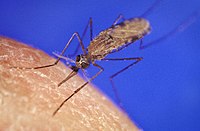
Photo from wikipedia
BACKGROUND Aim of our study was to identify conditions under which malaria transmission caused by imported infectious mosquitoes or travellers could occur at large central European airports, and if such… Click to show full abstract
BACKGROUND Aim of our study was to identify conditions under which malaria transmission caused by imported infectious mosquitoes or travellers could occur at large central European airports, and if such transmission could be sustained by indigenous mosquitoes. METHODS We developed a deterministic and a stochastic compartmental Susceptible-Exposed-Infectious-Recovered-Susceptible (humans)/Susceptible-Exposed-Infectious (mosquitoes) model with two mosquito (imported Anopheles gambiae, indigenous A. plumbeus) and three human (travellers, airport personnel exposed/not exposed to imported A. gambiae) populations. We assessed various scenarios to identify combinations of model parameters leading to ongoing malaria transmission at the airport. RESULTS The number of infected airport personnel was low (five infected employees/six months) under assumptions reflecting possible future climatic conditions, current passenger mobility and no desinsection of airports/aircraft. Almost all infections among airport personnel were directly due to bites by imported A. gambiae. Indigenous mosquitoes would need to have comparable transmission parameters to A. gambiae to sustain disease transmission. Incoming infectious passengers play only a minor role in malaria transmission. Use of aircraft/airport desinsection led to no transmission events in the model. CONCLUSION Our study shows that sustainable air travel-induced malaria transmission in central Europe is unlikely under current conditions or conditions which might become realistic in the next century.
Journal Title: Travel medicine and infectious disease
Year Published: 2020
Link to full text (if available)
Share on Social Media: Sign Up to like & get
recommendations!